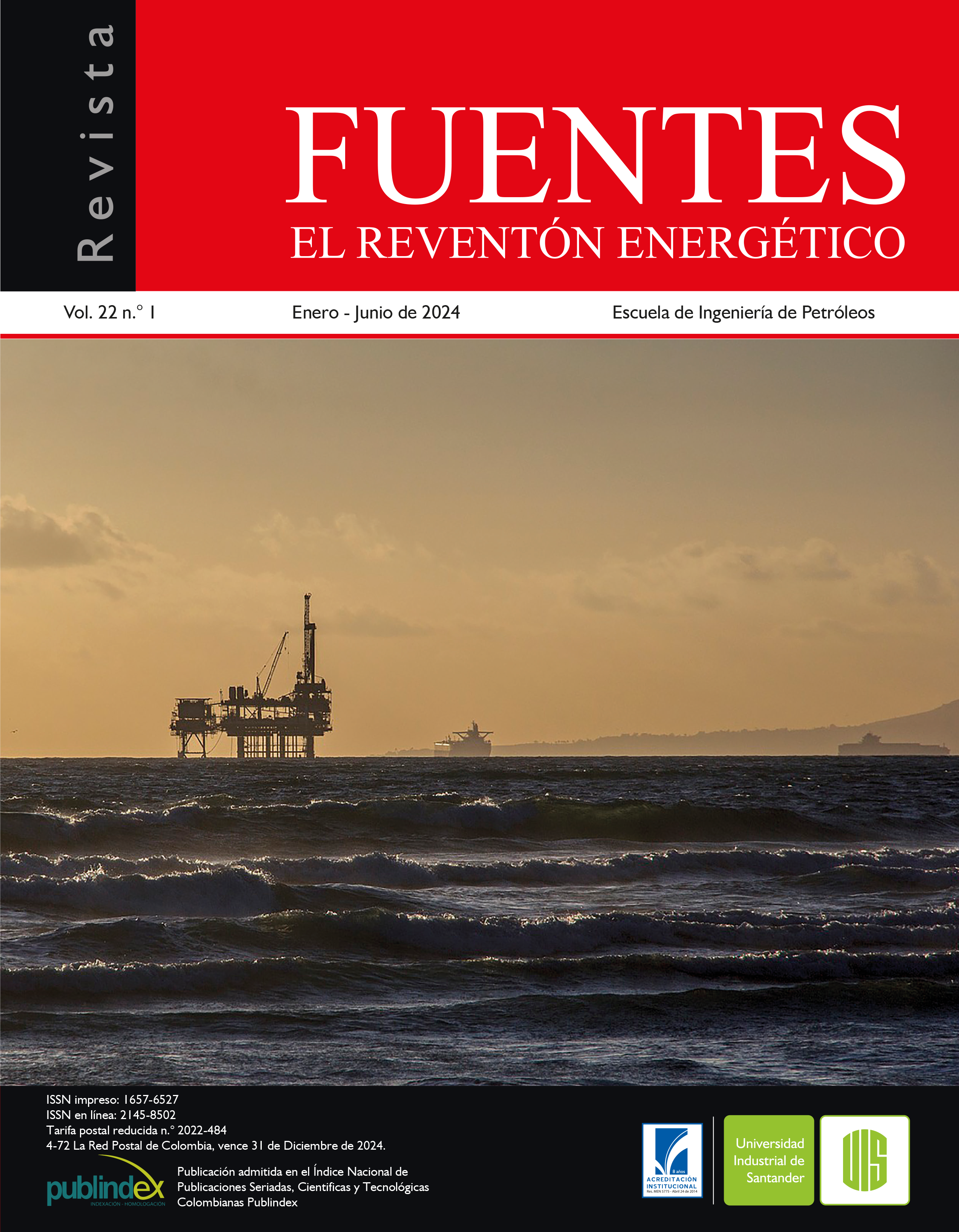ANALYTICAL SIMULATION IN COMPARTMENTALIZED RESERVOIRS TO PREDICT AND EVALUATE THE POTENTIAL AND PROFITABILITY OF INFILL DRILLING AND WATERFLOODING PROJECTS
Published 2024-09-09
Keywords
- infill drilling,
- volumetric reservoir,
- solution gas drive,
- compartmentalized reservoir
How to Cite
Copyright (c) 2024 Fuentes, el reventón energético

This work is licensed under a Creative Commons Attribution 4.0 International License.
Abstract
Analytical simulation reveals multiple aspects of reservoir dynamic complexity, as well as variability of input-output parameters linked to fluid data and relative permeabilities (Donohue et al., 1995; Houck & Cooley, 1983). The analytical model provides estimates of reservoir production and energy from infill drilling projects and secondary recovery models with lower uncertainty. The material balance was applied to a structural block visualized as a “tank”, represented as a compartmentalized reservoir with gas-in-solution conduction. The study area is a 135-acre structural block located in northwestern Peru, is a solution gas driven volumetric reservoir, which is depleted by 11 producing wells. The model was performed with the historical fitting of production data and pressures, then predictions were obtained with the drilling of five infill wells and the application of a water injection project. The results showed that for the compartmentalized block of the study only 3 wells are the optimal number of infill wells with an individual increase of 52 thousand barrels of oil (MBO) of reserves (above breakeven 46 MBO) with a total investment of 1.8 million USD for the 3 wells, reaching a total profitability of 2.24 million USD. In addition, a water injection project achieves pressure maintenance and incremental reserves of 147 MBO with an investment of 2 million USD, achieving a profitability of 2.105 million USD.
Downloads
References
- Basuni, M. N. (2018). Successful Infill Drilling in Raja Field Causes Ten-Fold Increase in Production. Indonesian Petroleum Association, 277-193. https://doi.org/10.29118/ipa.1322.277.293
- Craft, B. C., Hawkins, M. F., & Terry, R. E. (1959). Applied Reservoir Engineering. Prentice Hall, Upper Saddle River.
- Dake, L. P. (1983). Fundamentals of Reservoir Engineering. Elseiver.
- Donohue, J. M., Houck, E. C., & Myers, R. H. (1995). Simulation Designs for the Estimation of Quadratic Response Surface Gradients in the Presence of Model Misspecification. Management Science, 41(2). https://doi.org/10.1287/mnsc.41.2.244
- Driscoll, V. J. (1974). Recovery optimization through infill drilling - Concepts, analysis, and field results. Proceedings Of Fall Meeting Of The Society Of Petroleum Engineers Of AIME. 1974. https://doi.org/10.2523/4977-ms
- Erazo-Bone, R., Escobar-Segovia, K., Arcentales-Bastidas, D., Vargas-Gutiérrez, X., Arreaga-Arévalo, Á., & Román-Aguilar, A. (2019). Optimization of the drilling parameters in low angle wells by the application of statistical analysis. Proceedings of the LACCEI International Multi-Conference for Engineering, Education and Technology, 2019-July. https://doi.org/10.18687/LACCEI2019.1.1.78
- Fullana Belda, C., & Urquía Grande, E. (2009). Los modelos de simulación: una herramienta multidisciplinar de investigación. Encuentros Multidisciplinares, 11(32), 37-48.
- Gould, T. L., & Sam Sarem, A. M. (1989). Infill drilling for incremental recovery. JPT, Journal of Petroleum Technology, 41(3), 229–237. https://doi.org/10.2118/18941-pa
- Havlena, D., & Odeh, A. S. (1963). The Material Balance as an Equation of a Straight Line. Journal of Petroleum Technology, 15(08), 896–900. https://doi.org/10.2118/559-pa
- Hijar, M. (2022). Petrofísica de la Formación Pariñas Inferior en el desarrollo del yacimiento Alvarez Oveja, lote IV, cuenca Talara, Piura. [Tesis de pregrado, Universidad Nacional Mayor de San Marcos]. Repositorio institucional Cybertesis UNMSM.
- Houck, E. C., & Cooley, B. J. (1983). Experimental Strategies for the Estimation of Optimum Operating Conditions in Simulation Studies. Winter Simulation Conference Proceedings, 2, 403-404.
- Pletcher, J. L. (2002). Improvements to reservoir material-balance methods. SPE Reservoir Evaluation and Engineering, 5(1), 49–59. https://doi.org/10.2118/75354-PA
- Reviere, R. H., & Wu, C. H. (2003). An Economic Evaluation of Waterflood Infill Drilling in Nine Texas Waterflood Units. In SPE Reprint Series (Issue 56).
- Sills, S. R. (1996). Improved Material-Balance Regression Analysis for Waterdrive Oil and Gas Reservoirs. SPE Reservoir Engineering, 11(2), 127–134. https://doi.org/10.2118/28630-pa
- Trujillo, M., Rodriguez, E., Delgadillo, C., Claro, Y., Rojas, R., & Sandoval, J. (2018). Reduciendo la incertidumbre en la ejecución de un piloto de combustión in situ en un campo de crudo extra pesado colombiano mediante la realización de una prueba de conectividad con nitrógeno. Revista Fuentes, El Reventón Energético, 16(2), 109-120. https://doi.org/10.18273/revfue.v16n2-2018008
